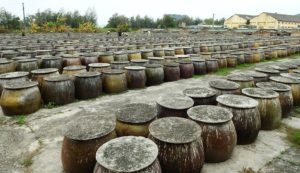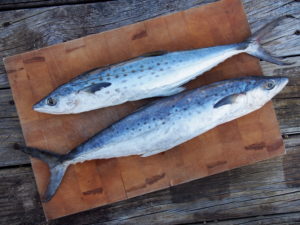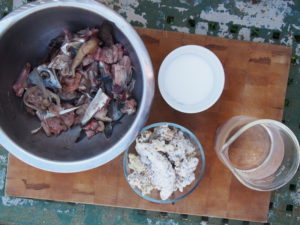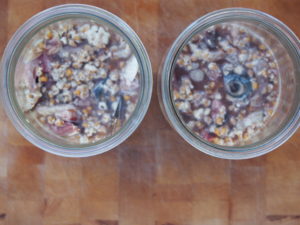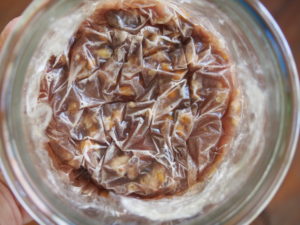The earliest evidence of fish sauces, or garums, dates back as early as the 3rd century BCE, made by ancient Greeks, and much speculation exists regarding whether the practice traveled from the shores of the Black Sea to the many other regions where garums are found, or if people across the Mediterranean, Asia, and elsewhere spontaneously developed their method for similarly preserving fish, without the help of trade. Modern day Tunisia, in North Africa, is where some of the oldest evidence of production can be found, in old garum factories carved from limestone, which would date to Carthaginian reign. When the Roman Empire took over, and sprawled across the Mediterranean, much of Europe, the Middle East, and Central Asia, culinary traditions spread with it. However, this doesn’t explain the origins of Scandinavian fish sauces, or garums found in Indonesia. What is certain is that where fish were abundant, fish sauces were the primary means of preserving and deriving maximum flavor and nutrition from fishery resources.
Fish Sauce varies in its chemical composition and flavor depending on where in the world it is made. Variations can be due to the fish available, the preference of the people making it, as well as climactic implications. Versions of fish sauce can be found in numerous countries, identifiable by their distinct names:
Indonesia: kecap ikan
Thailand: nam pla
Philippines: patis
Japan: shottsuru
Vietnam: nuöc mâm
Malaysia: budu
Myanmar: ngapi
France: pissala
Greece: garos
Iran: mahyaveh
Pakistan: Colombo-cure
China: yeesu
Korea: aekjeot
Fish sauce everywhere is just fish, slowly hydrolyzed, or broken down with water, by proteolytic (protein-digesting) enzymes. These enzymes come from the fish viscera (innards) and muscle tissue, as well as enzymes from microorganisms that may have been living on the fish. All animals have endogenous, or internally originating enzymes that aid in the digestion of their flesh. These only come in handy when the animal dies, and a process of autolysis, or an organism digesting itself, begins. No matter what fish sauce you’re interested in, you’ll find the common ingredients of whole fish, water, and salt. The fish and its internal organs and tissue provide the enzymes, and the salt offers stability by excluding harmful microorganisms that may spoil the product before autolysis can digest the fish.
Thus, the production of fish sauces the world over includes a mosaic of approaches to these basic ingredients, each method seeking to balance enzymes with salt as their palettes and climates allow. The ratio of these two ingredients within the context of temperature and time is what produces the lively variation in flavor, smell, stability, and overall character in garums everywhere. Analyses of almost 50 different fish sauces from the Phillipines, Southeast Asia, and Italy found salt contents ranging from 10-30%, overall protein content varying widely, and chemical and biological composition being similar, yet distinct from sauce to sauce. Think of it this way: there are many animals in the world which we call “fish”, but the species, shapes, colors, and other characteristics differ fantastically within their kingdom. It is as glib to generalize fish sauces as it would be to broadly generalize fish. What we can say is that they are fishy, nitrogen rich, and probiotic, to varying degrees and delights. Analyses of different sauces found 39 microorganisms representing 11 species of bacteria, 1 yeast, and 3 filamentous fungi.
A more traditional approach might unfold as follows: Once the ingredients are mixed, the fish is fermented in concrete vats for 9 months at temperatures between 30-37C/ 86-98.6F. The liquid, known as “liquamen” is captured then aged 3 months. Some cultures flavor the liquamen as it ages, with spices favored in the region. The residue, or “allec” from this initial extraction is often leached 2-3 times and mixed with brine to produce sauces of varying lower qualities, which are usually blended with various amounts of the primary extract. The final residue of bones and sludge is used as a fertilizer.
In the oldest accounts, these varying quality sauces were associated with status. Liquamen from the blood and guts was called “haimation” and considered most valuable, whereas the pastes made from the allec were relegated to lower classes. This may sound strange, but fish sauce was so valuable in the Roman Empire that amounts as much as one gallon could be traded for nearly a ton of wheat. This is likely due to the fact that it was so full of tasty umami, but also because of its important nutritional qualities. Research in Asia on the nutrient density of fish sauces has shown that they can contain significant levels of nitrogen, mostly in the form of essential amino acids. This means that consumption of just 40mL/1.5 ounces of fish sauce in a day can account for almost 8% of an individual’s needed protein.
Most traditional accounts call for a ratio of as little as 1.5 to as high as 4 parts fish for every 1 part salt. Higher salt contents are likely attributed to regions with warmer temperatures, as more heat would encourage microbes that may outcompete proper enzymatic reactions. Salt content in garums depends on how long the makers want to ferment, seasonal temperature flux, and time of year.
The type of fish varies, too. While most fish sauces are made from small fish like anchovies or sardines, larger sea fish are also used. The recipe included for this post uses mackerel, not an uncommon fish for garum. Most fish sauces are made with saltwater species, however there are accounts of ancient people using freshwater species from the Nile.
Modern adaptations of garum traditions are where fish sauces are being liberated. Far from falling into a strictly Asian culinary category, the sauces are being realized for their usefulness across the flavor spectrum. Chefs at world famous Noma are making garums from grasshoppers and bee pollen, and modern chefs worldwide are using garums in soups, vegetable pickles, and sauces. Because the flavor profile from such varying garums differs so much from the more traditional or familiar fish sauces, they provide the perfect umami kick behind the dominant flavor in the food.
Like many ferments in modern kitchens, garums are experiencing a revival, and in the excitement of rediscovery, there is the urge to hasten processing, and modify. One way of recasting the fish sauce process has been the popularization of using the mold koji (Aspergillus oryzae) as the enzymatic catalyst for autolyzation, which can reduce the need for fish viscera in the recipe, and also speed the production. If you’re unfamiliar with koji, you can learn more about it, and how to grow it yourself in my workshops on “Koji in Every Kitchen” as well as “Making Miso, Tamari and Soy Sauce (coming soon to our video archive).” Makers pairing koji with fish trimmings for their fish sauce can create garums absent of innards, using instead just the fins, bones, heads, and meat, and still achieve proteolysis, because koji possesses the enzymes to do the job, and do it quickly. With the power of koji comes the ability to further play with temperature and salt. Paired with the technology of incubators and other control devices, the evolution and variation of fish sauces advances and telescopes with an ever-quickening pulse. As you craft the fish sauce, here, you will jot your own record in the ancient tablet of garum stories. A messy, smelly, mysterious and wild effort oddly organized by a common quest for concentrated deliciousness.
Homemade Fish Sauce (or one approach, at least)
For this sauce, I purchased two whole mackerel, and filleted them. My family and I ate the filets smeared with miso and pan-fried, but the rest of the fish- bones, heads, eyes, guts, and fins, went to this sauce.
1 lb./500g mackeral parts
4.25oz/120g pearl barley koji (either purchases, or home grown- see our “Koji in Every Kitchen” or “Making Miso, Tamari & Soy Sauce Workshops for more info on Koji)
14oz./400mL non-chlorinated water
3/5 oz./100g kosher or non-iodized sea salt
Cut the mackerel pieces into roughly 1-inch pieces and place in a bowl. Crumble your koji and place it in another bowl. Measure the salt and set aside. Measure the water and have it ready.
Sterilize whatever jar or jars you’re using for the fish sauce. I find it easier to fill the jars with even amounts, and then mix the ingredients, rather than mixing everything and then trying to slop it into my jars. You will want head space in the container, so think about that beforehand. I split this recipe into two-quart Weck jars, to ensure I had enough head space in each. Place each jar on the scale and fill them up. In my case, each jar got half of the mackerel pieces, half of the salt, half of the koji, and half of the water. Once the jars are filled with their respective ingredients, mix the contents thoroughly with a wooden spoon.
Next, encourage a piece of Saran Wrap down into the jar, snugly on top of the sauce. Trim the edges and ensure that the sauce is covered by the plastic. Place the lids on the jars. If the seals are removable, remove them, as you will want gases to be able to escape as the sauce develops. I put the glass lids of the Weck jars on with the clips but left out the rubber sealing rings.
Label the jars with the type of fish used, the percent salt (in this case, 20%) and the type of koji. Place the jars into an incubator set to 98-100 degrees Fahrenheit. Allow to ferment for a minimum of 10 weeks before you begin tasting the results. Sample the liquamen to taste. If you want to age it further, return the jars to the incubator. If you want to decant the solids, do so, then bottle the liquamen and consider aging it for 2-3 months in a cool, dark cabinet or cellar. You may choose to add chiles, spices, or aromatics during this aging phase.
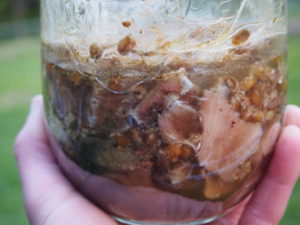
After one week. You won’t see much degradation of the fish pieces in the first 3-4 weeks. Don’t worry. Keep going 🙂
Note: Once you’re ready to decant the liquamen, be sure to use your residues or “allec” as well. If you’re not into making fish paste, use them in the compost pile or on the garden. Hydrolyzed fish protein is excellent food for beneficial soil fungi.
Storage: Your fish sauce should have stable water activity, due to the salt content of the recipe. As such, it will not need to be refrigerated, however you may choose to refrigerate it to cut down on the smell in your kitchen, and to keep it more stable. Add it by the drop to enhance soups, dressings, vegetables, and more.
